- Quick Read
- Deep Read ( 6 Min. )

Why is Christian Science in our name?
Our name is about honesty. The Monitor is owned by The Christian Science Church, and we’ve always been transparent about that.
The Church publishes the Monitor because it sees good journalism as vital to progress in the world. Since 1908, we’ve aimed “to injure no man, but to bless all mankind,” as our founder, Mary Baker Eddy, put it.
Here, you’ll find award-winning journalism not driven by commercial influences – a news organization that takes seriously its mission to uplift the world by seeking solutions and finding reasons for credible hope.
Explore values journalism About usMonitor Daily Podcast
- Follow us:
- Apple Podcasts
- Spotify
- RSS Feed
- Download
TODAY’S INTRO
Lighting a new way in college football
 Mark Sappenfield
Mark Sappenfield
Travis Hunter just turned college sports on its ear. Wednesday was National Signing Day in college football. Note the capital letters. In college football, this is the equivalent to the draft. It is when the nation learns where the top high school athletes are going. There are TV specials, hats – it’s a big deal.
Arguably the top prospect in college football, Mr. Hunter was going to go to Florida State. Until he wasn’t. Yesterday, he switched to Jackson State, a historically Black college and university (HBCU) that is a virtual minnow compared with Florida State (though coached by legend Deion Sanders).
The move isn’t unprecedented. Last year, top basketball recruit Makur Maker chose to go to Howard University, a prestigious HBCU, but a college basketball lightweight. Mr. Hunter is expected to garner significant commercial interest in naming, image, and likeness rights – something that has only recently become possible. That gives top athletes new autonomy. “With the advent of NIL deals,” The Athletic Pulse newsletter writes, “the landscape is fundamentally altered from a business perspective.”
That is Mr. Hunter’s hope. In a statement, he said: “I am making this decision so I can light the way for others to follow, make it a little easier for the next player to recognize that HBCUs may be everything you want and more: an exciting college experience, a vital community and a life-changing place to play football.”
Share this article
Link copied.

Help fund Monitor journalism for $11/ month
Already a subscriber? Login

Monitor journalism changes lives because we open that too-small box that most people think they live in. We believe news can and should expand a sense of identity and possibility beyond narrow conventional expectations.
Our work isn't possible without your support.
Jan. 6, and the larger plan to overturn the election
Emails and texts from former President Donald Trump’s chief of staff have filled in gaps and provided new details about the effort by Mr. Trump and his allies to overturn results of the 2020 election.

-
Dwight A. Weingarten Staff writer
Nearly one year after a mob smashed its way into the U.S. Capitol, new revelations have made clear that Jan. 6 may have been only one attention-getting part of a much deeper story. A report released this week by the House Select Committee investigating the Capitol attack provided startling new details about the relentless effort by President Donald Trump to overturn the results of the 2020 election.
The House voted Tuesday to hold Mark Meadows, Mr. Trump’s former chief of staff, in contempt of Congress for his refusal to testify about his interactions with the president and others on Jan. 6 and about his larger role as a key player in the attempt to reverse the 2020 results. Before he ended his cooperation with the committee, Mr. Meadows provided 9,000 pages of records, some of which offer glimpses into what he and others were doing behind the scenes as President Joe Biden’s inauguration drew closer, day by day.
“The White House was not simply a bystander in the activities at the Capitol building. They were central in coordinating and fomenting it,” says Cornell Clayton, a professor of government at Washington State University.
Jan. 6, and the larger plan to overturn the election

“Yes. Have a team on it,” Mark Meadows texted.
The date was shortly after last November’s presidential election. Mr. Meadows, then President Donald Trump’s chief of staff, was replying to a member of Congress who had asked whether the White House was urging GOP state lawmakers to send alternate pro-Trump electors to Washington.
In other words, would President Trump and his allies try to simply reverse the results in key states, no matter what the voters had actually decided? Mr. Meadows received a number of texts and emails from Republicans urging just such an action, though one admitted it would be “highly controversial.”
“I love it,” Mr. Meadows texted in response to one of these missives.
Nearly one year after a mob smashed its way into the U.S. Capitol, new revelations have made clear that Jan. 6 may have been only one attention-getting part of a much broader, deeper story.
In recent days, a series of revelations – including the release of texts offering a window into Mr. Meadows’ actions from November 2020 through January 2021 – have filled in gaps and provided startling new details about the relentless effort by Mr. Trump and his allies to overturn the results of the 2020 election.
That effort to overturn President Joe Biden’s victory now seems more deliberate and intentional, says Robert Lieberman, a professor of political science at Johns Hopkins University. In essence, President Trump and his allies went from door to door, pushing and rattling knobs to see if any would open and provide a path to remaining in office.
The former president and his team may be preparing the ground for a similar effort in 2024 if necessary, say some experts. In a number of key swing states, they’ve ousted recalcitrant election officials and tightened voting laws, while pushing allies to run for key positions.

Voters should understand that what’s at issue is not just whether their political “team” is going to win or lose, says Professor Lieberman.
“The most important thing for American citizens to begin to understand is that what’s at stake is democracy itself,” he says.
Contempt of Congress
On Tuesday evening, the House of Representatives voted to hold Mr. Meadows in contempt of Congress for his refusal to testify about his interactions with President Trump and others on Jan. 6 and about his larger role as a key player in the attempt to reverse the 2020 results. The Department of Justice must now decide whether to indict Mr. Meadows and prosecute him on the charge, which carries a penalty of fines and up to a year in prison.
Before ending cooperation with the Select Committee investigating the Jan. 6 attack, however, Mr. Meadows provided the panel with 9,000 pages of records, some of which offer glimpses into what he was doing behind the scenes as President Biden’s inauguration drew closer, day by day.
The texts between Mr. Meadows and members of Congress about state electors were among documents shedding light on the Trump strategy. The White House chief of staff also asked national lawmakers how to put the president directly in touch with state legislators, and discussed whether Vice President Mike Pence had the power to simply reject electors from certain states when overseeing counting of the Electoral College votes on Jan. 6.
President Trump “thinks the legislators have the power, but the VP has power too,” Mr. Meadows texted one U.S. senator, according to a committee resolution recommending contempt charges.
So far, the Jan. 6 panel has withheld the names of legislators who communicated with Mr. Meadows. That anonymity is unlikely to last.
“We will identify the authors of the text messages that we presented last night, and we will probably share some more information,” says Democratic Rep. Bennie Thompson, the committee’s chairman. “But we are not in a rush to do hearings.”
Overall, the Meadows documentary material lays out the step-by-step Trump post-election plan, say those who have seen it. First, rattle the door of state election officials to see if they’ll throw out votes. Second, engage higher state officials to see if they’ll pull rank. Third, call for more “audits” in key states. Fourth, push the Justice Department to launch fraud investigations, however thin the evidence – Mr. Meadows at one point sent Justice officials spurious allegations about bizarre foreign fraud plots.
Fifth, engage Congress, and encourage new elector slates. Then delay, whether by a Pence declaration that some state results were invalid, or some other means.
There’s no direct evidence the White House knew violence would erupt from the Jan. 6 “Stop the Steal” rally. But among the most startling texts in Mr. Meadows’ documents were pleas from Donald Trump Jr., Fox News hosts, and others that he push the president to tell the rioters at the Capitol to stop.
“We need an Oval address. He has to lead now. It has gone too far and gotten out of hand,” texted the president’s eldest son.
The texts don’t say anything about the president starting the riot. But their assumption is that he perhaps had the power to stop it.
“The White House was not simply a bystander in the activities at the Capitol building. They were central in coordinating and fomenting it,” says Cornell Clayton, a professor of government at Washington State University and director of the Thomas Foley Institute of Public Policy.
No hard evidence of fraud
Republican voters overwhelmingly say they believe the 2020 election was rife with fraud. A November poll, for instance, found that 65% of GOP-leaning respondents were not confident votes were counted accurately.
Their allegations range from the simple – that mail-in ballots weren’t correctly counted, or some people voted twice – to the grandiose and conspiratorial. Among the material Mr. Meadows submitted to the Jan. 6 panel was a 36-page PowerPoint slide deck that alleged that China has systematically gained control over the U.S. voting system and all electronic voting machines were compromised in 2020 – via an effort that included, among other things, a server in Frankfurt, Germany, and something called QSnatch that “grabs all Counties’ credentials.”
Mr. Meadows said he’d simply received the PowerPoint material in an email and done nothing with it. According to The Washington Post, a retired Army colonel named Phil Waldron had a hand in its creation. Mr. Waldron worked with Mr. Trump’s outside lawyers, and briefed Mr. Meadows and some lawmakers in Congress on the allegations, he told the Post.
The problem is there isn’t any hard evidence that fraud existed on anything like the scale needed to overturn an actual election.
Mr. Trump and his allies lost dozens of lawsuits on the subject following the election. His own attorney general said there were no signs of widespread fraud. His chief cybersecurity officer called them the most secure elections ever held. State and local officials of both parties declared the vote free and fair.
After reviewing every potential fraud charge in the six states disputed by the Trump campaign, The Associated Press found fewer than 475 allegations (some of which involve potentially fraudulent votes for Mr. Trump). Most were caught by officials and not counted, and the total number would not have changed the outcome.
Meanwhile, Trump allies are moving to perhaps make states more receptive to their fraud allegations in 2022 and 2024. They are doing everything from pushing supporters to fill low-level spots like election judges, to changing laws about how election results are handled.
In Arizona, Republican legislators passed a law that takes authority over election lawsuits away from the secretary of state, who’s currently a Democrat, and hands it to the governor, who’s a Republican. In Georgia, Republican lawmakers have weakened the powers of Secretary of State Brad Raffensperger, who refused Mr. Trump’s entreaties to change his state’s results. A candidate endorsed by the former president is running to replace Mr. Raffensperger in 2022.
Voters should understand that all these things are coming together in a confluence that makes this a dangerous time for democracy in America, says Professor Lieberman of Johns Hopkins University.
“If people can think about what’s going on in terms of whether or not democracy is going to survive, or whether this move or that proposal advances democracy or sets democracy back, I think that would be a [positive] step,” he says.

Settler attacks on Palestinians soar, challenging Israeli coalition
How does a centrist government respond as elements of society turn increasingly extreme? Israel is struggling to respond to new settler communities in the West Bank who are stirring unrest.
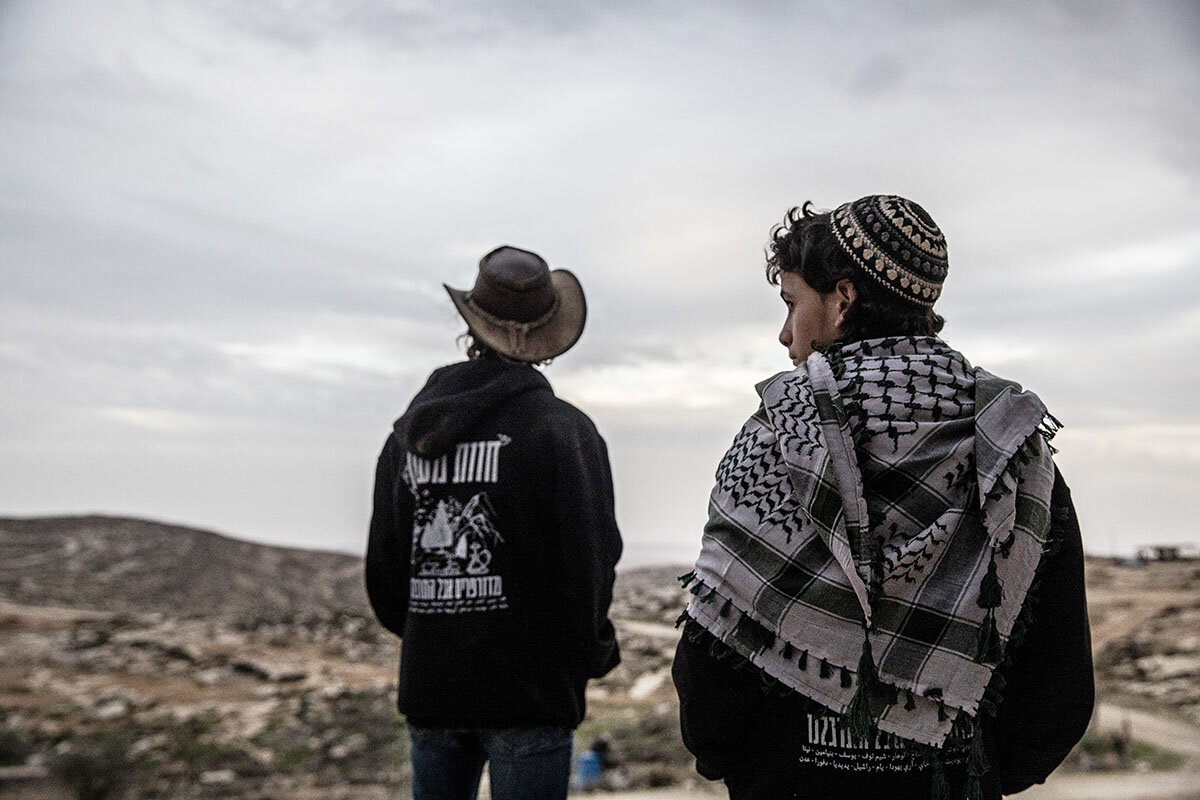
- Quick Read
- Deep Read ( 7 Min. )
Over the last two years, violence perpetrated by extremist settlers against Palestinians or their property has spiked by some 150%, according to Israeli Defense Ministry figures. The settlers’ intention, say observers, is to take over Palestinian land by intimidation.
The attacks reportedly are carried out mostly by residents of unrecognized settlement outposts. The extremists are emboldened by a radical interpretation of religious nationalism that preaches the land is their biblical birthright to seize, even by force. In their view, the state and even mainstream settler leaders have not been hard-line enough and have lost their moral standing.
The increased violence, and that extremist settler mindset, have set up a contentious issue for Israel’s broad new government, which includes a prime minister who was once a settlement movement leader, and left-wing and Islamist members.
Talia Sasson, a former chief state prosecutor, says the government’s response to the violence has fallen short and that despite declarations from some key ministers, no security crackdown has followed. She says the ideological conflict between Jewish Israelis for and against settlements puts army commanders in a difficult spot.
“This job puts them in the middle of the conflict,” she says, “and they don’t want to be there.”
Settler attacks on Palestinians soar, challenging Israeli coalition
On a rock-strewn slope, on land his family long has cultivated, Jibrin Abu Aram pushes a boulder to clear a path for the tractor plowing the chestnut brown earth.
The Palestinian farmer says he had feared coming to the field after having been attacked there recently by a group of Jewish settlers throwing stones.
“They told me to leave, to go to Jordan or Saudi Arabia, but I said, ‘I’m from here,’” says Mr. Abu Aram, who lives in the nearby village of Qawawis.
It was not the first time, he says, that he’s been attacked by settlers, and mounting tensions have him so distressed that he says he barely sleeps at night. So this time he asked pro-Palestinian Israeli activists for protection.
A pair stands close by, keeping watch, a video camera at the ready.
Over the last two years, violence perpetrated by settlers against either Palestinians or their property – uprooting olive trees, burning crops, stabbing sheep – has spiked by some 150%, according to Israeli Defense Ministry figures.
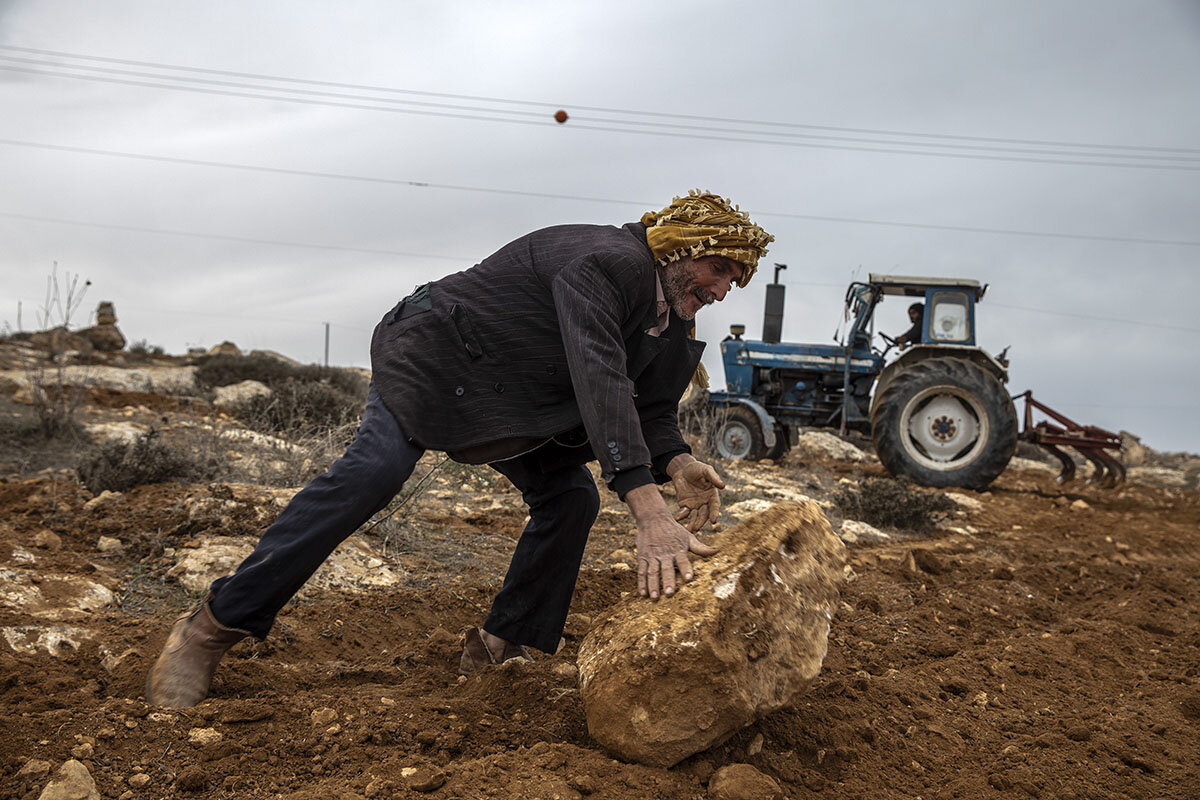
The settlers’ intention, say observers, is to take over Palestinian land by intimidation. The attacks reportedly are carried out mostly by residents of unsanctioned settlement outposts, who say the violence has been overstated. The real threat, they say, is from Palestinians trying to steal state land for themselves, and also that when settlers have resorted to violence, it’s usually in self-defense.
The settlers conducting attacks act largely with impunity. Although key government ministers have vowed a more forceful response, noticeable change on the ground has so far been absent, according to analysts and Israeli human rights groups. And the challenge to the fragile young government has become increasingly open and divisive.
New settler ideology
In the windswept, scrubby landscape of the Southern Hebron Hills, the extremist settlers are emboldened by a radical interpretation of religious nationalism that preaches the land is their biblical birthright to seize, even by force. In their view, the state and even mainstream settler leaders have not been hard-line enough and in turn have lost their moral standing.
“If your entire worldview is organized around religious concepts that say the entire Land of Israel is in the hands of Jews because God wanted it this way, then there is not much space for Palestinian land rights,” says Perle Nicolle-Hasid, a doctoral student at Hebrew University researching radicalism in Israel.
The ideology of those living on unsanctioned outposts and hilltops departs from that of the settlement movement’s founders, who viewed “the State of Israel as holy, so one cannot raise a hand against a soldier, and one is obligated to participate in the state as much as possible,” she says.
Outpost settlers “will tell you the State of Israel is relinquishing the Land of Israel, so it’s not as holy as they thought, and this further justifies their position regarding the Palestinians.”
The increased violence, and that extremist settler mindset, have set up a contentious issue for Israel’s broad new government, which includes a prime minister who was once a settlement movement leader, and left-wing and Islamist members.
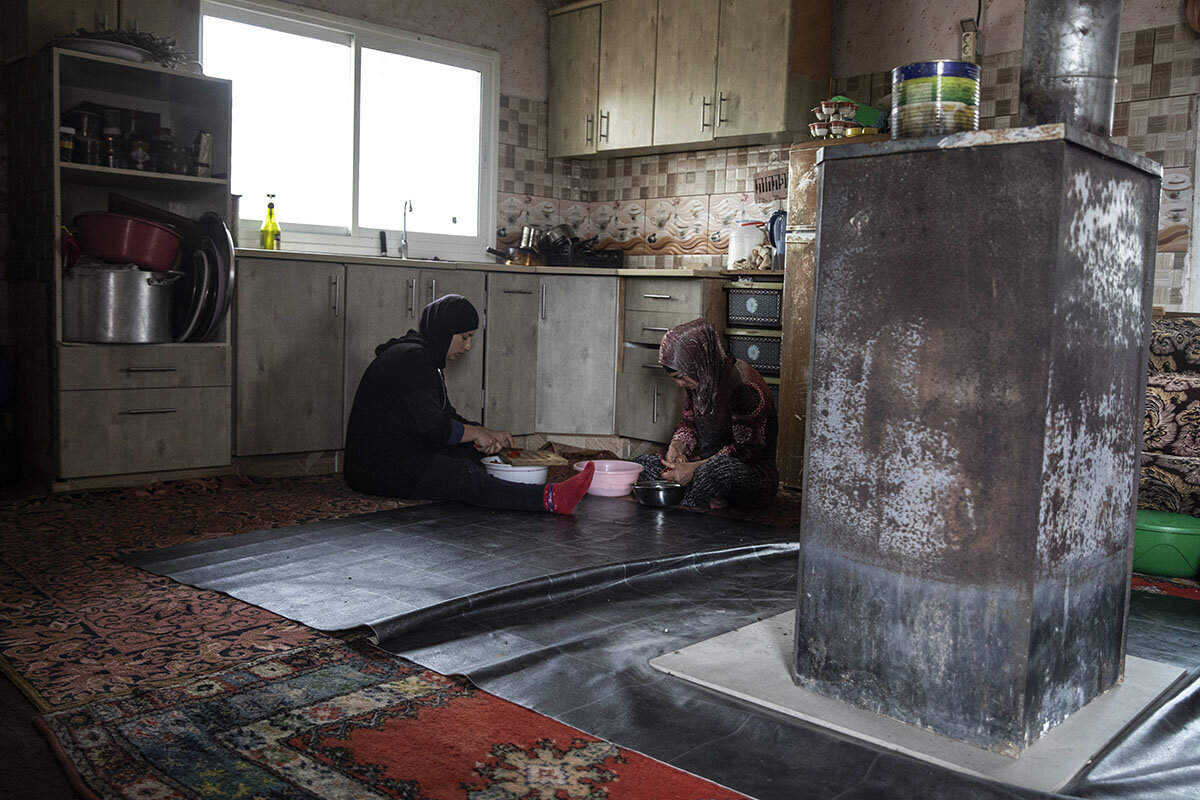
Fractured government response
Coalition frictions were on display this week as Prime Minister Naftali Bennett appeared to join right-wing critics of Public Security Minister Omer Barlev, of the center-left Labor party, who said he had discussed the rising settler violence with a visiting American diplomat.
West Bank settlers are “the defensive bulwark for all of us, and we must strengthen and support them,” Mr. Bennett said Tuesday. “There are marginal elements in every community, and they should be dealt with using all means, but we must not generalize about an entire community.”
Last month, Defense Minister Benny Gantz, a centrist, called an emergency meeting of security chiefs to coordinate more forceful action to protect Palestinians. In videotaped footage of recent settler clashes with Palestinians, soldiers can be seen failing to intervene. “Hate crimes are the root from which terror grows, and we need to root them out,” he said.
Foreign Minister Yair Lapid, Mr. Bennett’s principal coalition partner who is in line to take over as prime minister in 2023, described a particularly violent incident in September as “terror” and called for the “violent and dangerous fringe” perpetrating such attacks to be brought to justice.
Yet Talia Sasson, a former chief state prosecutor, says this government’s response has fallen short and that despite the declarations, no security crackdown has followed.
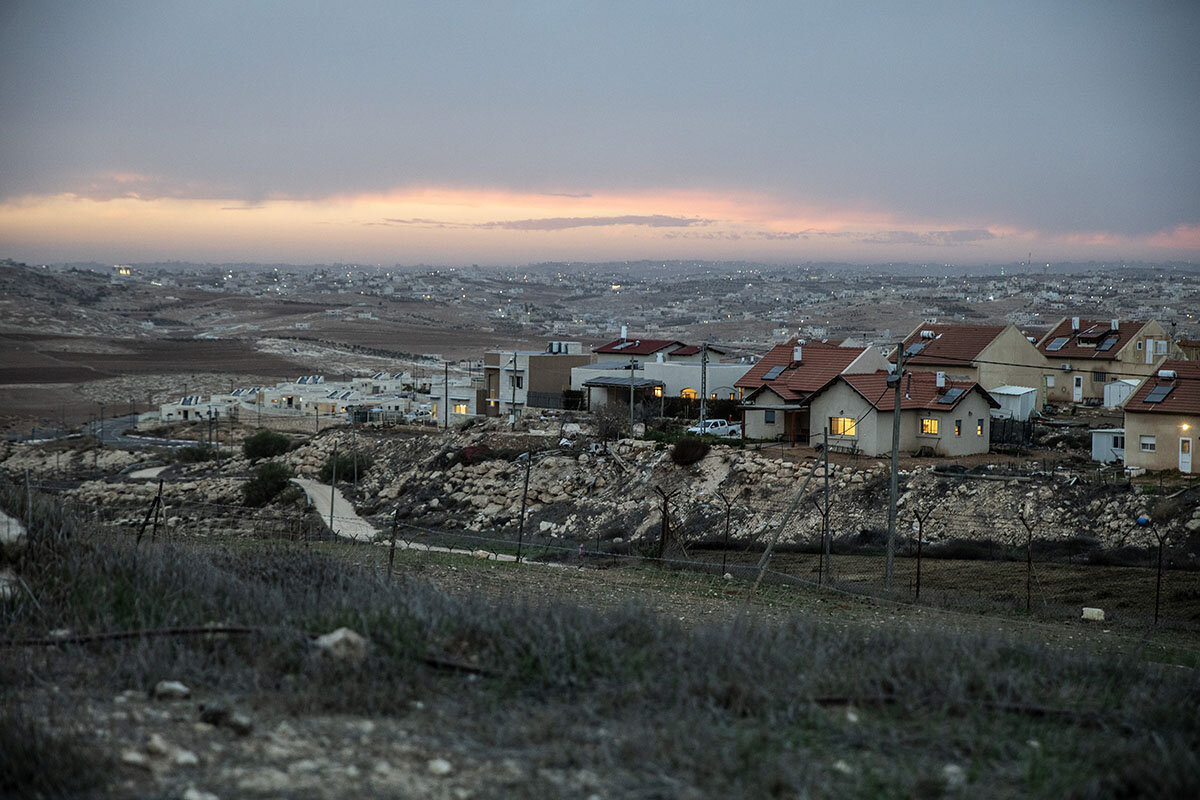
She says army commanders don’t want to be caught in the middle of an ideological conflict between Jewish Israelis for and against the settlements: “This job puts them in the middle of the conflict ... and they don’t want to be there.”
On Wednesday it was reported that Mr. Gantz and Mr. Barlev had agreed that hundreds of soldiers would be assigned policing duties in the West Bank so as to free police to tackle the settler violence.
For Lior Amihai, director of Yesh Din, an Israeli advocacy group, Mr. Gantz’s previous words felt empty. “The state plays a role here because it does not enforce the law on settlers. Instead it rewards them and is largely silent (about the violence). Investigations, arrests of settlers are rare – indictments even more so,” he says.
Havat Maon
Residents of the outposts, beginning with a handful of radical youth pitching tents on scattered hilltops across the West Bank in the early 2000s, have evolved into families living in hardscrabble farming villages.
Aware of their reputation as fringe elements in Israeli society – including among mainstream settlers – they have tried in recent years to rebrand themselves as embodying the ideals of Israel’s pioneer generation, sacrificing comfort to fortify the frontier. A Facebook page features advocacy posts and videos.
Havat Maon, an outpost of some 20 families, has a counterculture vibe. Wind chimes dangle on porches, children dance to thumping techno music, and residents describe themselves as artists and musicians who also work the land, herding goats and tending vineyards. The men typically have beards and long hair; the women cover theirs (per religious custom) in colorful scarves.
On a porch across from a sheep pen, a few friends in their 20s are hanging out. One, Alon, says he moved here seven years ago, drawn by the opportunity to build a meaningful life in a pastoral setting.
“See how quiet it is here?” he asks, gesturing toward the view of hills edging into a forest below. Unlike mainstream settlements, there is no fence, he boasts. “We don’t want to have a feeling we’re closed in. We want things to feel open and free.”
He says his friends do not engage in violent encounters, but when incidents occur, he blames the Palestinians, often instigated by Israeli leftists. He says it’s important to recognize the outpost population is itself diverse – some are messianic and disconnected from mainstream Israel, others, including himself, are not. But they do, he says, share a basic ideology that Jews have a right to live here.
The most severe recent violence took place nearby, when dozens of settlers, masked to shield their identity but reportedly from Havat Maon and Avigayil, swarmed the Bedouin village of al-Mufaqara, after clashes between villagers and settlers.
Videos show them throwing stones into houses – one of which hit a 3-year-old boy, leaving him unconscious – and smashing car windows. Some Palestinians retaliated with stones. Reportedly there were injuries on both sides.
Alon said in incidents like this, one sees the videos but not what happened before. Citing past attacks in nearby settlements by Palestinians, including killings, one of his friends adds, “There’s too much trauma” to seek reconciliation.
Yaakov Nagen, a settler who does outreach with Palestinians and believes that is the way forward, has had a very different reaction to the surge in violence, as, he says, have other mainstream settlers. “Personally, all the acts of violence have horrified me,” he says.
Rabbi Nagen says traumas suffered by both Jews and Palestinians from decades of tension and aggression have led to “a demonization of the other,” which facilitates violence.

Susiya
Last month, a new playground in the Bedouin village of Susiya was taken over by settlers who said it was built illegally. Soldiers followed and blocked residents from entering, declaring the whole village a closed military zone.
“As Palestinians you feel constantly threatened here that our lives can be taken over not just by settler violence but by the state itself, which lets the violence continue,” says Nasser Nawaja, a Susiya resident and field researcher for B’Tselem, an Israeli rights group.
Noting the Israeli volunteers who come daily to protect Susiya, some in his home as he spoke, he says: “Settlers have attacked them as well. We are all in this battle together.”

Patterns
Gig contractor or employee? Delivery drivers seek rights worldwide.
App-based delivery firms rarely classify their drivers as employees deserving benefits. But the push for fair treatment is gaining traction in courts worldwide.

- Quick Read
- Deep Read ( 4 Min. )
From Los Angeles to Moscow, on their bikes and motorcycles, they’ve been the skeleton key that has pried open pandemic isolation by delivering everyday necessities, and comforts, to families around the world.
Yet these gig economy drivers share something else. Often struggling to make ends meet, they mostly lack basic employment benefits. Now, however, that may be changing.
Last week, the 27-nation European Union unveiled a proposal that would give these workers the same rights as employees of traditional brick-and-mortar businesses, and the move is part of a global trend.
Until now, most of the app-based delivery companies have styled themselves as mere matchmakers between ostensibly independent “contractors” and customers. That way they have escaped the wage and benefits overhead that traditional businesses have to pay.
Strikes in Latin America, court cases in Britain, trade union negotiations in Italy: One way or another the drivers are asserting their rights, and the companies are being made to take responsibility for the people they pay.
For the app-platform companies, the gig may not be up. But it is, undeniably, changing.
Gig contractor or employee? Delivery drivers seek rights worldwide.

They’ve been everywhere.
From Los Angeles and London to São Paulo and Moscow, on their bikes and motorcycles, in sweltering heat or bone-chilling cold, they’ve been the skeleton key that has pried open pandemic isolation by delivering everyday necessities, and comforts, to families around the globe.
Yet these gig economy drivers share something else. Often struggling to make ends meet, they mostly lack basic employment benefits such as a minimum wage, health insurance, paid time off, or the right to appeal if they’re fired.
Now, however, that may be changing.
Last week, the 27-nation European Union unveiled a proposal that would give them the same rights as employees of traditional brick-and-mortar businesses.
And that was just the latest of a growing number of challenges to the business model that has underpinned the expansion of gig economy companies worldwide: firms like Doordash, Grubhub, UberEats and its ride-sharing parent, Uber, in America; or Deliveroo and Just Eat in Europe.
Styling themselves as mere matchmakers – a high-tech connecting point between ostensibly independent “contractors” and customers – the firms have escaped the wage and benefits overhead that traditional businesses have to pay.

When Uber led the rush toward app-based services a decade ago, that seemed like a win-win proposition. Not only did it promise convenience and lower costs for consumers. It would give workers – first, Uber drivers, now tens of millions of delivery bikers as well – a chance to choose their hours and make some money.
That arrangement still works for those who do delivery work or driving as an occasional side gig to top up their earnings from another job. But recently there’s been a swell of complaints from the many more who rely on their gig earnings to feed themselves and their families.
That swell has intensified over the last two years, with drivers braving not just the elements and the risk of accident, but the pandemic.
In the United States, the jury on gig worker benefits is still out. Though the federal government has signaled support for greater rights, the key decisions are being made at the state level. The outcome of the highest-profile case so far is in the balance: A California law giving gig workers significantly greater rights was overturned by a ballot proposition which is now headed for a fight in the courts.
Yet elsewhere, the trend is clearer.
Delivery drivers have staged strikes across Latin America. The campaign began with an online video posted by a gig worker in São Paulo, Brazil. He alleges that when a flat tire on his bike delayed a delivery, he found himself blocked from his gig company’s app.
In effect, fired.
Similar cases have been going before courts around the world. Most rest on the same fundamental argument: that far from being “independent contractors,” gig workers are every bit as answerable to their bosses as employees in other businesses. In fact, they have even less independence, since decisions over when and where to send them, and whether to fire them, rely on computer algorithms.
How will policymakers, and the gig companies, respond? And can these businesses, most of which are not yet making a profit, offer basic rights to their workers and still be viable?
In Europe, the pendulum is now moving in the direction of the workers.
Earlier this year, Britain’s Supreme Court upheld a claim for a minimum-wage guarantee by two dozen Uber drivers. It ruled that they were not, in fact, freelance “contractors,” because of the wide array of tools the company used to exert control over them.
Uber had a responsibility to ensure they received the national minimum wage and paid holiday time, the court ruled.
A number of EU states have also moved to improve the gig workers’ lot. France has proposed letting drivers elect union representatives to negotiate better working conditions. In Italy, a deal has been reached requiring delivery businesses to spend hundreds of millions of dollars to improve working and safety conditions for their drivers – though stopping short of recognizing them as full-fledged employees.
In August, however, Spain passed a law requiring Uber and the gig economy delivery platforms to offer that very recognition.
Last week’s proposal from the executive arm of the EU, the European Commission, in effect proposed this approach for all member states. It said that the burden of proof to demonstrate that companies were, in fact, just acting as matchmakers must rest with the companies. Workers who were not genuine freelancers – as many as four million of them, according to EU estimates – must enjoy the same rights and protections as formal employees.
One major gig business – Just Eat, Europe’s largest – has said it will respect that, but most others are opposing the proposal. Uber argues that it would jeopardize the jobs of thousands of its drivers, and hurt the customers who rely on them.
Still, Uber has suggested that a way might be found to retain the gig economy’s “flexibility” – in other words, the existing business model – while “allowing platforms to introduce more protections and benefits.”
It remains to be seen what emerges from the lobbying and negotiations that will now ensue. The Commission proposal has to go through the EU legislative process before a vote, in its final form, by the European Parliament. It’s likely to be a year or two before that happens.
But the tide does seem to be turning to the workers’ advantage, and expanded benefits and protections appear inevitable.
For the app-platform companies, the gig may not be up.
But it is, undeniably, changing.

Film
From ‘King Richard’ to ‘Gunda’: The 10 best films of 2021
Like many moviegoers, Monitor film critic Peter Rainer felt a power in returning to theaters. Here are the films that brought him the most joy this year – on the big and small screen.

- Quick Read
- Deep Read ( 5 Min. )
-
By Peter Rainer Special correspondent
I distinctly remember when I saw my first movie on the big screen in 2021. The experience of sitting in a big, booming theater, at long last, was a revivifying reminder of what first drew me to the movies – and what draws me still.
Despite many grace notes, this past year was predictably odd for movies. The coming year should restore some semblance of normalcy to film production, which has become faster and cheaper, at least in the low-budget indie realm.
Streaming channels are making it possible for many more of these films to be seen than ever before – a boon for young, talented filmmakers.
The list this year reflects that trend. Among the films on it are “Mass,” a drama that explores forgiveness after a school shooting, from actor Fran Kranz in his debut as a writer-director, and the jubilant documentary about a 1969 music festival “Summer of Soul,” the first film directed by Ahmir “Questlove” Thompson. Those are joined by movies such as “King Richard,” an enjoyable biopic about the father of tennis greats Venus and Serena Williams, and the transporting “Gunda,” which invites us to experience the lives of farm animals.
From ‘King Richard’ to ‘Gunda’: The 10 best films of 2021
I distinctly remember when I saw my first movie on the big screen in 2021. It was “In the Heights,” the Lin-Manuel Miranda musical, and perhaps I can be forgiven for thinking, as the movie started up, that it was the greatest film ever made. I felt this way because the experience of sitting in a big, booming theater, at long last, with larger-than-life actors parading across the screen, was a revivifying reminder of what first drew me to the movies – and what draws me still.
Since that time in June, I have seen many more movies in theaters, and quite a few more on the home screen. I’ve made my tentative peace with this bifurcated approach to moviegoing. It was true, after all, even before the pandemic, that movie audiences were increasingly migrating to the small screen. But I do hope, in vain perhaps, that in a post-pandemic world, audiences of all ages will once again throng the theaters for all kinds of movies, not just the blockbusters.
Despite many grace notes, this past year was predictably odd for movies. How could it not be when so many of the offerings were completed before the pandemic hit, with their releases delayed sometimes for a year or more? The coming year should restore some semblance of normalcy to film production, which is great news, but, again, under what conditions will these new movies be experienced?
The silver lining in this current movie maelstrom is that filmmaking, at least in the low-budget indie realm, has become a faster and cheaper process. Streaming channels both large and small make it possible for many more of these movies to be seen than ever before. However these movies are made or viewed, it will be an incalculable boon if young, talented filmmakers, many of whom might otherwise have lacked the opportunity, break through and do important work.
I was grateful in this fraught movie year for even partial pleasures. Some of the films I was rather mixed about still contained wonders: the remarkable, shape-shifty Kathryn Hunter, who plays all three witches in “The Tragedy of Macbeth”; Olivia Colman’s simmering despair in “The Lost Daughter,” Maggie Gyllenhaal’s directorial debut; actor Tôko Miura’s personal driver, with her deep well of grievance, in “Drive My Car”; Ciarán Hinds and Judi Dench as the grandparents in “Belfast,” whose relatively brief screen time has a novelistic density; and, perhaps best of all, the freestyle verve of writer-director Paul Thomas Anderson’s coming-of-age-in-the-1970s mishmash, “Licorice Pizza.”
And now, in no particular order, my 10 best list, based on movies that opened in theaters and/or online, for a regular run in 2021.
1. The Disciple – Written and directed by Chaitanya Tamhane, this deeply heartfelt drama about a devotee of Hindustani classical music is one of the most powerful films I’ve ever seen about the ways in which art can both exalt and entangle the lives of its practitioners. Sharad (Aditya Modak), the young vocalist, must come to terms with the fact that, in the musical world he reveres, he has talent, not genius. And yet, by the end, what the movie is saying is that some things are even more important than art. (Netflix; rated TV-MA)

2. Quo Vadis, Aida? – The slaughter, in 1995, of more than 8,000 Bosnian Muslims in eastern Bosnia-Herzegovina is the centerpiece for this impassioned memorialization written and directed by Jasmila Žbanić, who was living in Sarajevo when the massacre occurred. It’s a political thriller but also, with its moral gravitas, so much more than that. Its main protagonist, Aida, a first grade teacher acting as a translator for United Nations officials, is played by Jasna Ðuričić, and the year held no finer performance. (Available on streaming services; not rated; English subtitles)

3. Gunda – A black-and-white documentary about the daily life of farm animals, with no humans in sight and no narration, may not sound like the stuff of greatness, but “Gunda,” directed by Victor Kossakovsky, transports us with a hushed reverence into their lives, especially Gunda and her dozen or so piglets. The film’s embrace of the natural world is absolutely transcendent. (Available on streaming services; rated G)
4. Summer of Soul – This jubilant documentary, the directorial debut of Ahmir “Questlove” Thompson, utilizes long-unseen footage of the 1969 Harlem Cultural Festival overflowing with great Black artists, among them Nina Simone, Sly and the Family Stone, Stevie Wonder, B.B. King, and Gladys Knight and her irrepressible Pips. (Hulu; rated PG-13)
5. The White Tiger – Few movies have depicted the indignities of the caste system as devastatingly as “The White Tiger,” written and directed by Ramin Bahrani from the Booker Prize-winning novel and featuring a chilling, quicksilver lead performance by Adarsh Gourav. The film plays like the anti-“Slumdog Millionaire,” and it’s all the truer for that. (Netflix; rated R)
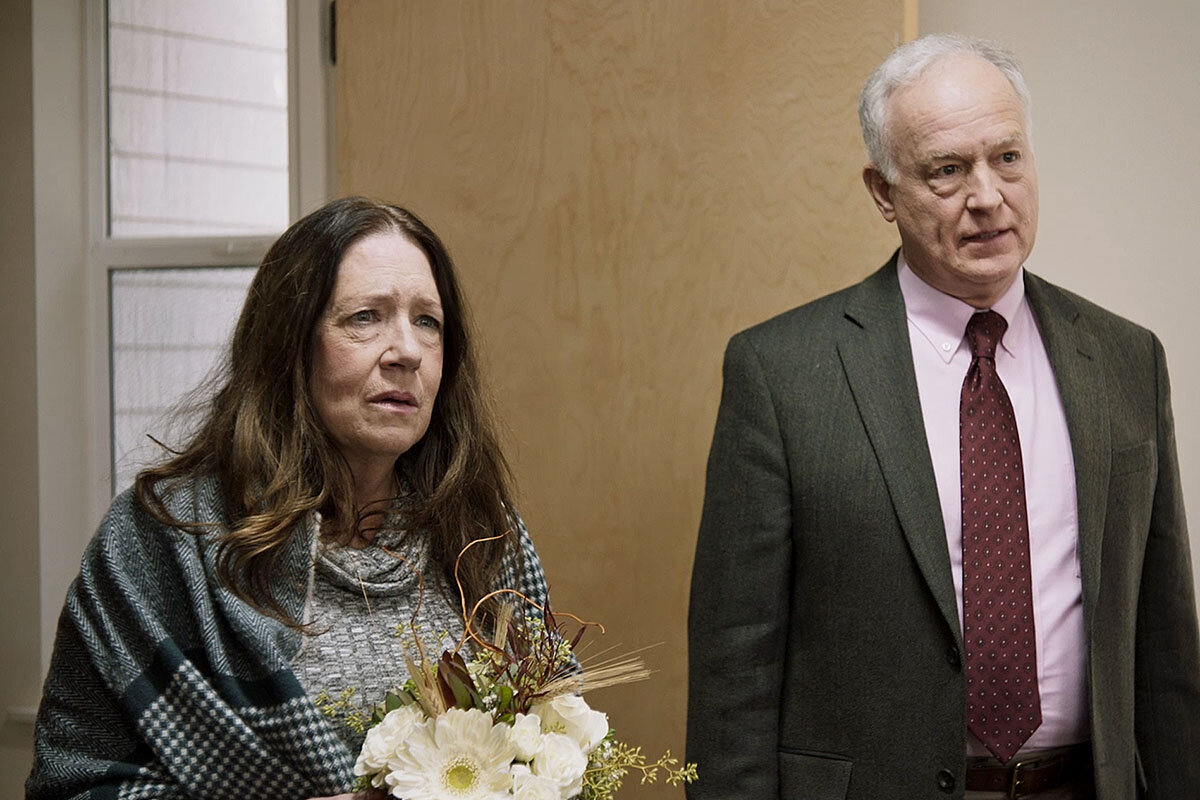
6. Mass – Years after a high school shooting tragedy, the parents of the shooter, by arrangement, meet for the first time face-to-face in a church basement with the parents of a boy who died in the massacre. Fran Kranz’s writing-directing debut is a searing moral examination of the possibility of forgiveness. The ensemble cast members, Martha Plimpton, Reed Birney, Jason Isaacs, and, especially, Ann Dowd, are extraordinary. (Available on streaming services starting Dec. 28; rated PG-13)
7. King Richard – This is the most sheerly enjoyable crowd-pleaser of the year, with Will Smith’s best performance yet as Richard Williams, the exasperatingly driven father of tennis greats Venus and Serena Williams. Playing his wife, Aunjanue Ellis gives as good as she gets. Added bonus: Unlike most sports movies, the actors here actually look like they can play the sport. (HBO Max through Dec. 19, and in theaters; rated PG-13)
8. Milkwater – Writer-director Morgan Ingari’s auspicious feature debut is about a young woman (played by Molly Bernard) who agrees to act as a surrogate birth mother for her gay friend (Patrick Breen), and the emotional distance that comes between them. Touching, funny, unsentimental, and wonderfully acted. (Available on streaming services; TV-MA)
9. Boiling Point – During one night in a high-end London restaurant, filmed in a single take, the staff and chefs and clientele engage in enough hubbub (and cussing) to fill out a dozen lesser movies. Director and co-writer Philip Barantini is a wizard at drawing out sizzling performances on the fly. (Available on streaming services; rated R)
10. Language Lessons – Yet another terrific debut feature, this one is from director Natalie Morales, who co-stars in this two-character study with co-writer Mark Duplass. He plays Adam, who was gifted by his husband with 100 one-on-one online Spanish-language lessons before tragedy struck. He reluctantly goes ahead with the lessons – he in Oakland, California, and Cariño (Morales), his teacher, in Costa Rica. Don’t let the rom-com, Zoom-centric trappings put you off. The emotions coursing through this movie are deeply felt. (Available on streaming services; not rated)
A few other worthies: “West Side Story,” “Old Henry,” “Spencer,” “Pig,” “The Truffle Hunters,” “The Velvet Underground,” “Roadrunner: A Film About Anthony Bourdain,” and “The Last Duel.”
Peter Rainer is the Monitor’s film critic.
Other headline stories we’re watching
(Get live updates throughout the day.)The Monitor's View
Message from the young: The future’s going to be all right
- Quick Read
- Deep Read ( 2 Min. )
-
By the Monitor's Editorial Board
Two recently released surveys ask about views of the future based on age groups.
In the United States, Generation Z (ages 13 to 24) and millennials (ages 25 to 40) were more confident about the future and their ability to bring about positive change than the older Generation X (ages 41 to 56). That’s based on a newly released poll conducted by MTV and The Associated Press-NORC Center for Public Affairs Research.
A separate UNICEF-Gallup survey taken across 21 countries, rich and poor, and released last month showed that 57% of younger people (ages 15 to 24) believe the world is getting better with each passing generation, compared with only 39% of older people (age 40 and up).
In the half-dozen richest countries, only about a third of people 15 to 24 years old thought children today will be better off economically than their parents. But in poorer countries, especially in Africa and South Asia, about two-thirds of the younger group said children today will be better off than their parents.
Reports of these positive attitudes among young people – the architects of the future – help inspire confidence that the challenges that lie ahead will be met.
Message from the young: The future’s going to be all right
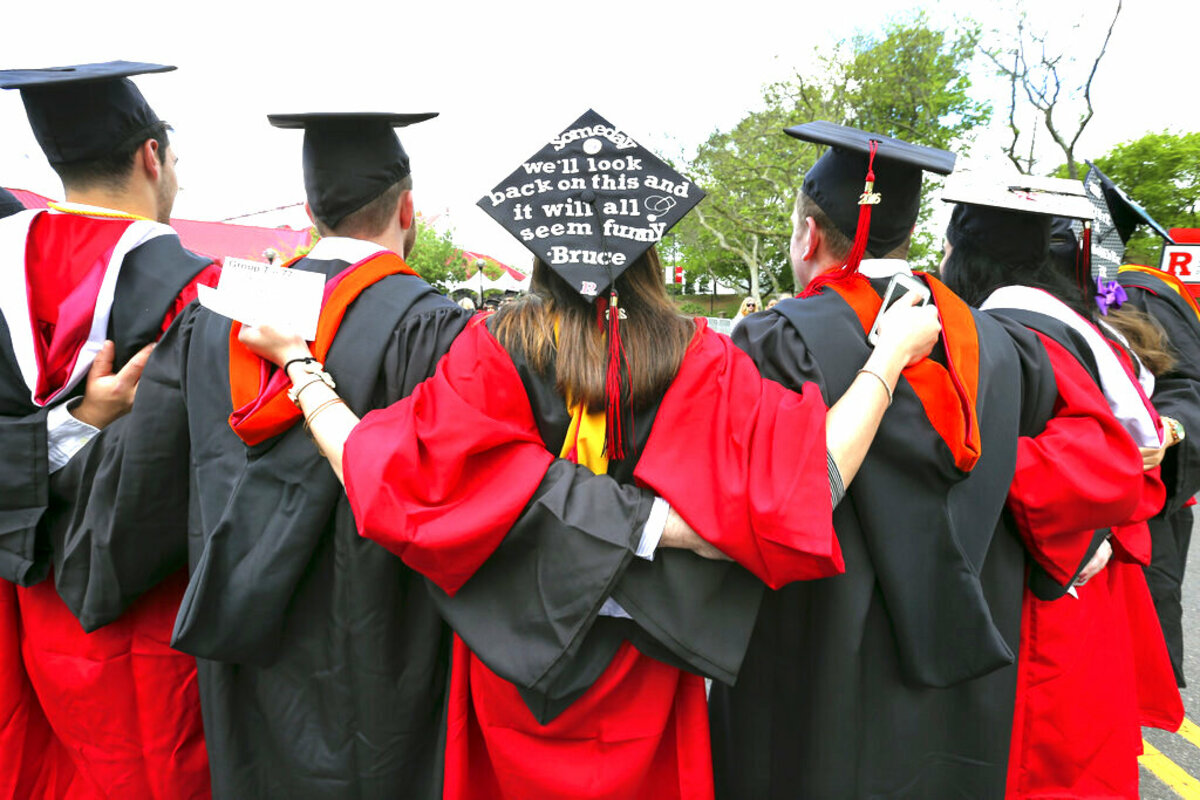
In the midst of climate change, a pandemic, and economic uncertainties, young Americans stand out as the generation most confident that the future is going to get better. And worldwide, the young people in poorer nations are even more confident than those in wealthier nations.
Those are the conclusions of two recently released surveys that ask about views of the future based on age groups.
In the United States, Generation Z (ages 13 to 24) and millennials (ages 25 to 40) were more confident about the future and their ability to bring about positive change than the older Generation X (ages 41 to 56). The survey reported that 66% of Gen Z and 63% of millennials say their generation is motivated to make positive change, compared with 56% of Gen X.
That’s based on a newly released poll conducted by MTV and The Associated Press-NORC Center for Public Affairs Research.
In addition, the younger Gen Z (45%) and millennials (41%) are more optimistic than the older Gen X ( 33%) that Americans will be able to come together and work out their political differences.
“Where I find the most hope is when I talk to people and we find the common ground,” said Jonathan Belden, a 29-year-old from New Mexico and a father of five children. “When that happens, even if there are differences, it helps me to feel like there is actually good in people and in the world.”
A separate UNICEF-Gallup survey taken across 21 countries, rich and poor, and released last month showed that 57% of younger people (ages 15 to 24) believe the world is getting better with each passing generation, compared with only 39% of older people (age 40 and up).
In the half-dozen richest countries, though, only about a third of the younger age group replied that they thought children today will be better off economically than their parents. But in poorer countries, especially in Africa and South Asia, about two-thirds of the younger group said children today will be better off than their parents.
Why the optimism? One answer might be that in recent decades, standards of living have been rising in many poorer countries. And growing access to the internet has created new opportunities for education and employment.
“I think when you have less, it fuels you to seek more,” said Lorraine Nduta, a 21-year-old in Nairobi, Kenya. “The power to change any situation lies with us – hard work, consistency, and discipline.”
Commenting on the report in The New York Times, Sharlene Swartz, a sociologist at the Human Sciences Research Council in Pretoria, South Africa, also noted that her research has shown the positive outlook of youths in poorer countries is related to their religious faith and strong family and community ties.
Reports of these positive attitudes among young people – the architects of the future – help inspire confidence that the challenges that lie ahead will be met.

A Christian Science Perspective
Each weekday, the Monitor includes one clearly labeled religious article offering spiritual insight on contemporary issues, including the news. The publication – in its various forms – is produced for anyone who cares about the progress of the human endeavor around the world and seeks news reported with compassion, intelligence, and an essentially constructive lens. For many, that caring has religious roots. For many, it does not. The Monitor has always embraced both audiences. The Monitor is owned by a church – The First Church of Christ, Scientist, in Boston – whose founder was concerned with both the state of the world and the quality of available news.
The satisfying peace of Christmas
- Quick Read
- Read or Listen ( 3 Min. )
-
By Kim Crooks Korinek
Christmas – the celebration of Christ’s appearing – comes to us in quietness and humility, bringing with it the lasting peace that can only come from God.
The satisfying peace of Christmas
The house was full of relatives and friends celebrating Christmas loudly and happily. Needing a little escape from the noise, I ducked into my bedroom to be alone. In the calm of my room, I was a little surprised at how quietly happy I felt. I didn’t need to rush back out and join in the fun right away, but reveled in this moment of feeling God’s satisfying love and gentle presence right where I was.
Years later, I was alone for Christmas – away from family and friends while working at a resort. On Christmas Day, a few other staff members and I enjoyed some moments of laughter and a gift exchange of wrapped items from the vending machine. Yet, most of my time was spent being still, aware of the Christly affection I felt expressed by and for others.
To me, these instances were tangible examples of what Mary Baker Eddy refers to as “Truth’s appearing,” when writing about how she liked to observe Christmas. She said, “I love to observe Christmas in quietude, humility, benevolence, charity, letting good will towards man, eloquent silence, prayer, and praise express my conception of Truth’s appearing” (“The First Church of Christ, Scientist, and Miscellany,” p. 262).
Christmas represents the appearing of Christ, the spiritual idea of Truth. And I realized that whether I was alone or with others, whether I had an abundance of gifts or none, the appearing of Christ, Truth, as a gentle and loving presence is a constant, because divine Truth is changeless. Listening for the Christ in quiet moments helps me to yield to the Christmas message that God, divine Love, is supreme, governing us all, and this comforts and heals.
In another of her writings about Christmas, Mrs. Eddy, who discovered Christian Science, beautifully describes the connection between Truth’s appearing and healing protection: “The star that looked lovingly down on the manger of our Lord, lends its resplendent light to this hour: the light of Truth, to cheer, guide, and bless man as he reaches forth for the infant idea of divine perfection dawning upon human imperfection, – that calms man’s fears, bears his burdens, beckons him on to Truth and Love and the sweet immunity these bring from sin, sickness, and death” (“Miscellaneous Writings 1883-1896,” p. 320).
Truth’s appearing comes from omnipotent and omnipresent God, whose influence cannot be hid by human busyness, by threats of isolation or contagion, or by any form of sin, disease, or death. Truth overcomes all discord, and this knowledge reassures us. The all-knowing God “feed[s] the famished affections,” forgives as we forgive others, and leads us into a greater understanding of our God-given health, purity, and grace (see Mary Baker Eddy, “Science and Health with Key to the Scriptures,” p. 17).
Truth’s appearing may come in a wide variety of ways. But it often comes to our thinking in ways that are quiet and unexpected. Jesus’ birth is a perfect example. At the time, there was much anticipation of the coming of the Messiah and how this arrival might look – all grand and outwardly glorious narratives. But the actual appearance of the Messiah, as Jesus born in a manger, was unexpected, humble, yet powerful beyond all worldly calculations.
We can prepare our own mangers and humbly make room to receive the Christ, which Jesus exemplified, by letting into our experience the sacred influences of unselfishness. This is shown in our spontaneous generosity, honesty, and compassion; in our revolutionary philanthropy, shown in going beyond our comfort zones to express kindliness, benevolence, and love for all humanity; and in our spiritual affection – reflecting that holy, adoring, pure embrace of God to all Her creation.
Whether we are spending Christmas surrounded by others or alone, the comforting, constant reappearing of the Christ, Truth, is the essential element that gives the satisfying peace all can feel at Christmas and always.

A message of love
Tea for two

A look ahead
Thank you for joining us today. Please come back tomorrow when our Scott Peterson looks at how the Taliban view free speech. On one hand, the answer might be more nuanced than you expect. On the other, it’s totally predictable: Criticism is unacceptable.


